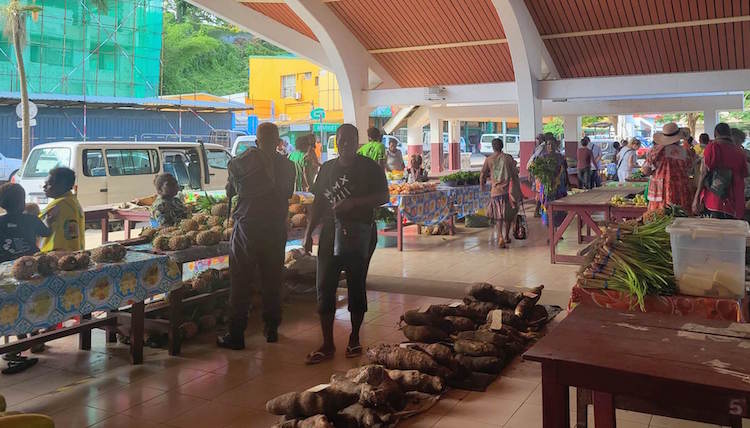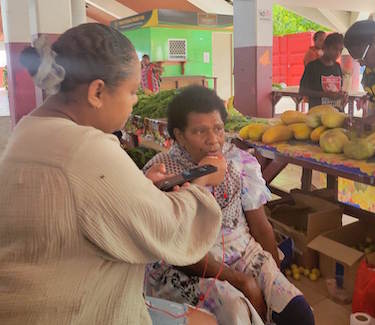Related News

Central Market in Port Vila. Picture: Josepheen Tarianga
By JOSEPHEEN TARIANGA
In the first week of March this year after days of cyclone warnings—it did finally come. Not one but two cyclones and a devastating earthquake—all within a week. When the cyclones came, there was already a chill in the air and dark looming clouds.
The trees had been trimmed, the roofs secured and food had been stocked. Families were gathered to wait out the cyclones—now known as Judy and Kevin. But no one was prepared for two Category 4 cyclones to hit the country a day apart, leaving the country devastated.
A week after the cyclones hit, the Asian Development Bank (ADB) said they would provide a $1 million grant to the Government of Vanuatu to supplement government finances following tropical cyclones Judy and Kevin, which caused severe damage to roads, schools, health facilities, homes, essential water and power infrastructure, and crops.
The World Bank chipped in with the disbursement of a $9.5m grant to support the Government of Vanuatu’s response. The government announced that it launched an early recovery plan on 14 April, with a budget of $28m.
Three months after the cyclones, how do people see Vanuatu’s cyclone recovery? I spoke with members of the Vanuatu community with different standing and socioeconomic status to find out.
“Every year from November to April we know that we have a cyclone season. People are prepared for that,” Elsie Molu, a Vanuatu resident, told Wansolwara.
She has lived in Vanuatu all her life and has experienced many cyclones growing up.
“When the cyclone hit in March, we didn’t expect anything else. Everybody went back to cleaning up their backyards, sorting out the rubbish, and repairing their houses. People know that cyclones have hit us but we have to move on.”
She described how NGOs (non-governmental organisations) involved in disaster relief would come around.
“Everybody knows they are in go mode and will be coming around, to find out who needs aid, who needs support …. not financial aid, but tools, equipment, and things they need to rebuild and tie them over until they could find something more permanent.”
While NGOs and the National Disaster Management Office (NDMO) have been working as first responders, some communities feel that they have not received enough help and support for recovery.
“During the cyclones, I was with my community, and some houses were so damaged that some people were scared and they left,” Isaac Viraliliu, a chief of the Ambae Island community told Wansolwara.
“The NDMO came only once and until now they have not stepped into the community. Some of us live as if the cyclone is still here. They gave us rice and tuna. But two months later they gave nothing. For those who work it’s ok, but for us who do not work, it’s a challenge.”
Viraliliu added that the cyclone damaged many of their houses and trees fell on their roads.
“Two months have gone and the trees have been cleared but in terms of development, we are closed up. Things are green again but the people are still suffering,” he said.
Chief Viraliliu lived in the D’york Street community for over 20 years. He expressed that while the community may be green again there is still much recovery in communities to be done. The D’york Street community has been registered for the Digital cash transfer by the Government, but the community is not convinced this will help in recovery.
“We see that the UN has given a lot of money for aid and the minister of finance has talked about it, but our community does not see where the money is going,” added Viraliliu.
“They said they will come but I hear there is an obstacle somewhere. We are still waiting for the cash and food aid they have told us about. But D’york has only received help once.”

The Government has indicated that there should be a few transactions for the Digital cash transfer by July of this year with over 6,000 households targeted, but market vendor Jaqueline Tasso raised some concerns shared by her fellow vendors.
“The cash flow is what the government of Vanuatu has promised to give to the people affected by the cyclone. The way we hear it, the amount will not be enough to cover the cost of what we have lost,” said Tasso, who would like government officials to come down to the level of the grassroots people (visit communities) and hear their thoughts.
“Before they limit the amount of cash to be given to the people. When we listen to the media, we hear the minister of finance trying to explain the cash transfer. The total to be given by the minister of climate change, we are not happy.
“We feel the stimulus package is what can help us because we buy permits to operate our businesses and we pay daily for the tables we use to operate our markets,” she explained.
Tasso gave Wansolwara the cost of operating a market vending business for people like herself. They have to pay 400 Vatu for the table and 200 Vatu for the floor space and if she cut flowers to sell, she has to fork out another 200 Vatu.
“That is eight hundred Vatu,” she pointed out, adding, “the table permit is 13,500 Vatu (USD 114). When you calculate that amount plus 5,000 Vatu for a business license, the amount given by the government will not meet the expenses and will not solve our problem”.
Though it may seem that the country is fully recovered from the cyclones, it could not be further from the truth for farmers.
“There are widows, women leaders, and a lot of single mothers that gain their living mainly through the market. We use it for school fees, we pay for our homes and every living cost of our families through the market,” notes market vendor Tasso, who grows the crops she brings to market.
“The government is not helping us at all,” she laments.
“In my garden, I plant island cabbage, manioc, banana, taro, and legumes. But I have to replant because those I planted, trees have fallen on them. A lot of us you see at the market are now using only a small cleared patch of land to try and grow food, replant, and bring to the market.
“But the recovery is not complete. For us farmers, there is still so much recovery to be done.”
The rippling effects of the cyclone have shifted the livelihoods of the people’s day-to-day life and even education. Isabella Iata, a Grade 11 student at Central School told Wansolwara that their school year has been affected by the cyclone devastations.
“After the twin cyclones, most of the schools have been damaged. We did not go to school for about four weeks,” recalls Iata.
“We couldn’t do online learning because most of the areas did not have electricity for the entire four weeks and some even more.”
She said that the school had one week break this year, though normally they used to have two weeks.
“It makes us miss out on so many things at school and our workload is high,” complains Iata.
“Now we are trying to catch up on everything.”
While the country is green and lush again and there are only a few remaining visual scars from the cyclone’s visit. The people are still struggling to pick up the pieces.
While there is some support provided and talk of help, the people still feel that there is no proper consideration of the extent of the damage the cyclones have left behind. There is still a long way to go before life in Vanuatu fully recovers from the damages of the cyclones.